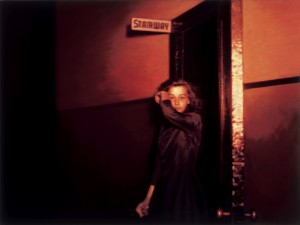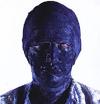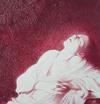Artweek, Volume 33, Issue 12 – November 30, 2002
"Downtown", Modernism Gallery, 2002
GOTTFRIED HELNWEIN AT MODERNISM
"This was the moment when I sensed for the first time," Helnwein has since written, "[that] you can change something with aesthetics, you can get things moving in a very subtle way, you can get even the powerful and strong to slide and totter, anything actually if you know the weak points and tap at them ever so gently by aesthetic means." For the following three-and-a-half decades he has relentlessly pursued that goal, masterfully incorporating everything from painting to performance to photography, regularly causing art world outcry and public fury. Yet as his knockout exhibition at Modernism last October made clear, his art is successful less for its evident tendency to provoke than for its extraordinary ability to perplex.

The first and last enduring lesson Gottfried Helnwein learned in art school came about the day he refused to sketch yet another classic nude, and instead took a razor to his fingers and drew a portrait of Adolph Hitler in his own blood. The year was 1965, the city Vienna, and all Austria seemed tacitly to have agreed that responsibility for Nazi atrocities would be forgiven if only the whole horrid era were forgotten. So, rather than praising Helnwein's exceptional draftsmanship, using so painfully original a technique, his instructor gathered the entire faculty and accused him, in front of the student body, of attempting to ruin the school's reputation.
"This was the moment when I sensed for the first time," Helnwein has since written, "[that] you can change something with aesthetics, you can get things moving in a very subtle way, you can get even the powerful and strong to slide and totter, anything actually if you know the weak points and tap at them ever so gently by aesthetic means." For the following three-and-a-half decades he has relentlessly pursued that goal, masterfully incorporating everything from painting to performance to photography, regularly causing art world outcry and public fury. Yet as his knockout exhibition at Modernism last October made clear, his art is successful less for its evident tendency to provoke than for its extraordinary ability to perplex.
Ambiguity, of course, has always been the essence of art, setting it apart from mere commentary. Many, from Robert Arneson to Barbara Kruger, have ultimately failed for putting their work in the service of polemic. Had Helnwein taken too fervently to the lesson he learned in art school - had he simply chosen to be an effective agitator - he assuredly would have suffered the same fate. In truth, that initial portrait of Hitler, while gutsy, isn't especially deep. It served as a point of departure, but once he was on his way, the Austrian painter, now working in Los Angeles, let his distance from it grow greater by the hour.
In Downtown (17), we see a woman lying in a tub, apparently dead, while another kneels beside her as if in prayer. Both are unclothed, yet their mutual nudity exposes nothing about either. On the contrary, the cause of that unsettling situation, and its effect, are cropped out, eliminated with all spatial context, every last clue. The image has the look of a noir film still, without fitting into a larger story. An act of violence has been committed, one to which we are privy, yet we don't know how or why it happened. Worse, it's unclear whether we're witness to criminal activity or just watching a scene from a movie.
So we loiter. We stare. We stick around longer than is quite seemly. We draw away only after framing the scene, deciding that the women are either rivals, or lovers, that one is either the other's killer, or could have been her savior. And we implicate ourselves through what we choose to believe. We participate in the violence, acting on that scene: By bringing it to life, we put one of the figures to death. Does it matter if we're seeing a movie? We become, aesthetically, accessories to murder.
Helnwein's whole Downtown series, the substance of this exhibition, presents us with situations that call for our intervention, yet hold tragedy as a forgone conclusion by infuriatingly only allowing us into the scene too late. We see ruined bodies and beaten faces. Or we peer in on the action from above as in Downtown (11), a rooftop brawl just beneath our reach. We try to approach, only to find that the blur of action grows so great we can no longer discern one figure from another, a first from a face. In his restrained blue grisaille, Helnwein creates the candid look of photography with painterly vagueness: the closer we come to the scene of the crime, the farther we are from knowing what's happening. We can search as much as we wish, but brushwork masks all hard information - whether there's death on the roof, fear or expectation to be read in the expression of the bathing woman.
The ambiance of malice in Helnwein's Downtown sequence metaphorically captures the violence ever lurking beneath the surface of our society - generally only visible from afar, or after the fact, or in a movie - suggesting the culpability of a people who watch so impassively. But, more importantly, Helnwein draws out the thirst for blood lying just beneath our skin.
Gottfried Helnwein - New Paintings closed November 2 at Modernism, San Francisco.
Jonathon Keats is a freelance writer based in San Francisco.


